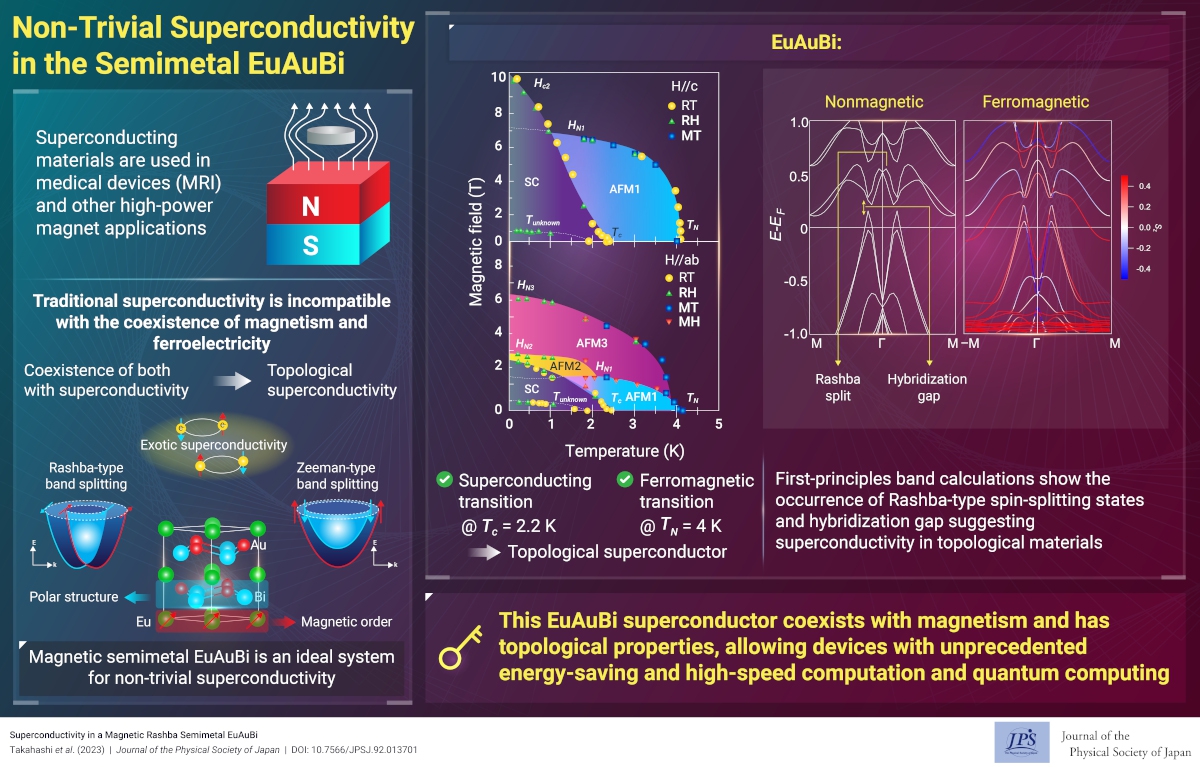Non-Trivial Superconductivity in the Semimetal EuAuBi
© The Physical Society of Japan
This article is on
Superconductivity in a Magnetic Rashba Semimetal EuAuBi
(JPSJ Editors' Choice)
J. Phys. Soc. Jpn.
92,
013701
(2023)
.
Magnetic order and superconductivity coexist in a noncentrosymmetric topological semimetal, EuAuBi. EuAuBi exhibits a large, anisotropic critical field with Rashba spin–orbit coupling, which can help develop superconducting spintronic materials.

In conventional s-wave superconductivity described by the Bardeen–Cooper–Schrieffer (BCS) theory, superconducting Cooper pairs are mediated by phonons, and these pairs (spin singlet) exhibit time-reversal and space-inversion symmetries. Therefore, magnetism and polarity that break these symmetries are generally incompatible with s-wave superconductivity. By contrast, superconductivity in systems without time-reversal and space-inversion symmetry has recently attracted attention as unconventional superconductivity. In particular, systems without space inversion symmetry exhibit a mixture of singlet and triplet pairing states. Furthermore, topological materials with surface states demonstrate spatial inversion symmetry breaking at the crystal interface, thereby providing a possibility for developing materials with unusual surface superconductivity.
In this study, we successfully synthesized a single crystal of the topological semimetal EuAuBi, which has a layered structure comprising magnetic Eu triangle and conducting Au-Bi honeycomb layers. The synthesized crystal demonstrated antiferromagnetic and superconducting transitions at 4 and 2.4 K, respectively. The polar structure of this material is responsible for the alternating displacement of Au and Bi ions, resulting in a unique system that exhibits magnetic ordering and superconductivity with a polar structure.
To investigate the superconducting properties of this material, changes in the superconducting transition temperature were measured down to as low as 0.1 K by applying an in-plane and an inter-plane magnetic field. Consequently, a superconducting critical field of 10 T, considerably greater than the Pauli limit expected for conventional superconductivity, was observed in the inter-plane field, while the critical field was only 3 T in the in-plane field. First-principles calculations revealed that Rashba spin splitting and a topological band structure are realized owing to the polar structure and strong spin–orbit coupling of Bi p orbitals. Therefore, the large critical field above the Pauli limit and its anisotropy may reflect a Rashba-type band structure and surface superconductivity, suggesting the realization of unconventional superconductivity.
For the first time, we unveiled superconducting properties in the topological semimetal EuAuBi, which exhibits magnetic order and polar structure. The coexistence of large magnetization and superconductivity in this system may accelerate the development of spintronic materials that exhibit a novel external field response.
(written by H. Takahashi on behalf of all the authors. )
Superconductivity in a Magnetic Rashba Semimetal EuAuBi
(JPSJ Editors' Choice)
J. Phys. Soc. Jpn.
92,
013701
(2023)
.
Share this topic
Fields
Related Articles
-
Higher-Order Topological Phases in Magnetic Materials with Breathing Pyrochlore Structures
Electronic structure and electrical properties of surfaces and nanostructures
Magnetic properties in condensed matter
Mathematical methods, classical and quantum physics, relativity, gravitation, numerical simulation, computational modeling
2025-4-7
A simple example of a higher-order topological phase, in which the symmetry decreases step-by-step from the bulk to the corner, is realized in a magnetic system with a pyrochlore structure and is characterized by a series of quantized Berry phases defined for the bulk, surface, and edge.
-
Existence of Chiral Soliton Lattices (CSLs) in Chiral Helimagnet Yb(Ni1-xCux)3Al9
Magnetic properties in condensed matter
2025-4-1
Our study examines the magnetic structure of the monoaxial chiral helimagnet Yb(Ni1-xCux)3Al9, providing first direct evidence of the formation of chiral soliton lattice state.
-
Fractional Vortex Array with Nontrivial Topological Structure Realized at Twin Boundary of Nematic Superconductor
Superconductivity
2025-3-24
Analysis of the two-component Ginzburg-Landau theory suggests that a conventional vortex is transformed into two fractional vortices with the topological nature of core-down and core-up merons at the twin boundary of a nematic superconductor.
-
Exploring the Vibrant Interplay of Machine Learning and Physics
Cross-disciplinary physics and related areas of science and technology
Electron states in condensed matter
Elementary particles, fields, and strings
Mathematical methods, classical and quantum physics, relativity, gravitation, numerical simulation, computational modeling
Statistical physics and thermodynamics
Superconductivity
2025-3-13
This Journal of the Physical Society of Japan Special Topics edition explores how physics and machine learning complement each other and can solve unresolved problems in physics.
-
Understanding Pressure-Induced Superconductivity in CrAs and MnP
Magnetic properties in condensed matter
2025-3-10
This study reviews existing research on the pressure-induced variation of magnetic properties of transition metal mono-pnictides like CrAS, MnP, and others, aiming to understand the unconventional superconductivity observed in CrAs and MnP.




